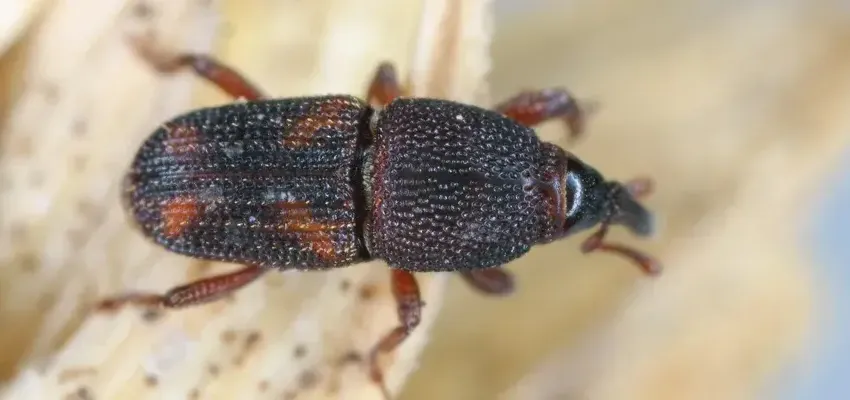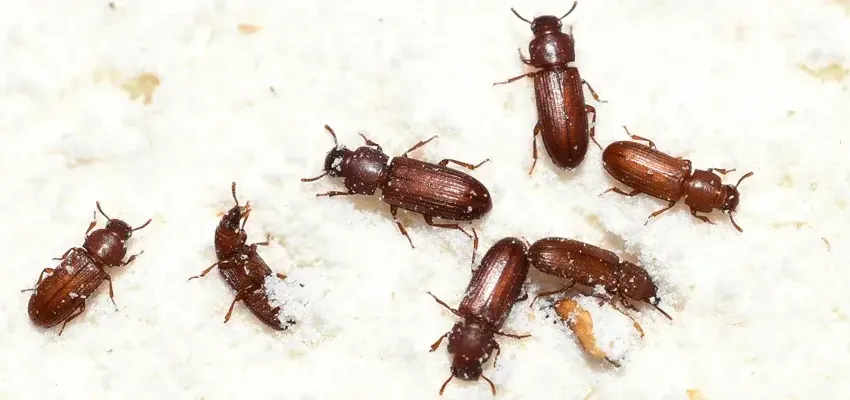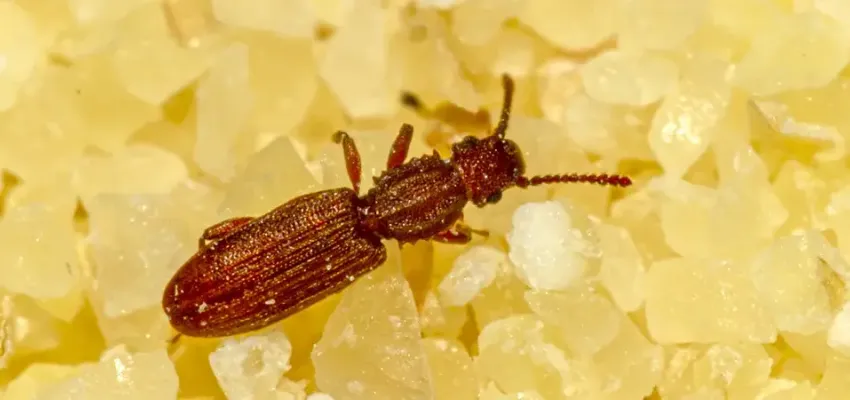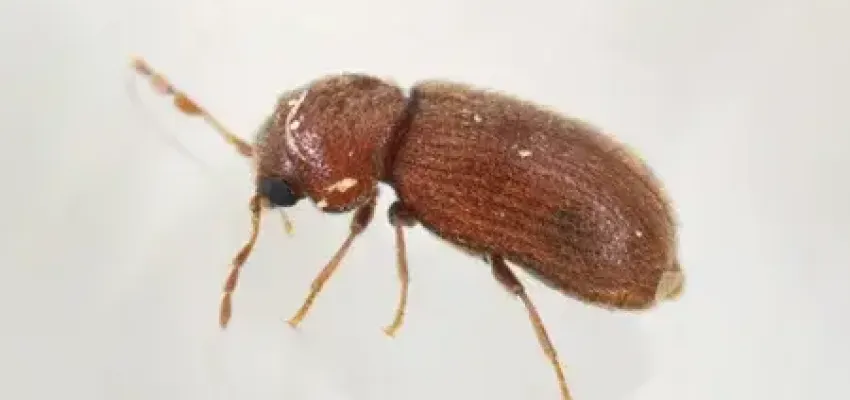Common Pantry Pests in North Carolina: Identification and Prevention Tips

As a homeowner in North Carolina, it's crucial to protect your pantry from unwanted invaders, especially pantry pests. These pests can contaminate your food and create an unsanitary environment in your kitchen. Understanding how to identify common pantry pests and knowing how to prevent them can save you time, money, and stress.
Here are some of the most common pantry pests found in homes across North Carolina:
Indian Meal Moths (Plodia interpunctella)

Indian meal moths, also known as flour moths, grain moths, or pantry moths, are one of the most common pantry pests. These small moths lay eggs in dry food products such as cereal, flour, and dried fruit. The larvae of these moths burrow into food, creating holes and leaving behind webbing. If you spot adult moths flying around your pantry, it’s likely a sign of an infestation.
Appearance
- Adult Indian meal moths are small, measuring about 1/2 to 3/4 inches in length. They have distinctive, colorful wings with a coppery-brown band across the middle and light grayish-brown tips.
- The larvae, which are the primary culprits of pantry damage, are cream-colored to light brown with a darker head.
Signs of Infestation
- You may notice adult moths flying around your pantry or kitchen, especially at night.
- Their larvae often leave behind a telltale trail of webbing in dry food products like flour, cereal, rice, and dried fruit.
- You might also see holes or web-like structures inside food packages or bags.
Where They Hide
- Indian meal moths prefer dark, undisturbed corners of pantries. They tend to infest grains, cereals, dried fruit, nuts, and bird seed.
Rice Weevils (Sitophilus oryzae)

Rice weevils, also known as grain weevils, rice flour weevils, or oryzae weevils, are tiny, dark brown insects that infest grains, rice, pasta, and other dry foods. These weevils often enter homes through packaged food products and lay eggs in the grain. Once the eggs hatch, the larvae feed on the food, causing visible damage and contamination.
Appearance:
- Rice weevils are tiny, dark brown beetles, about 1/8 inch long, with distinctive snouts extending from their heads. Their bodies are oval and slightly flattened.
- Their coloration can range from dark brown to almost black, with small, rounded pits on the wings.
Signs of Infestation:
- You’ll notice tiny, round holes (about the size of a pinhead) in grains like rice, pasta, and cereal.
- These holes are a sign that larvae have been feeding on the food.
- If you open an infested bag or box, you may find rice weevils moving inside the product.
Where They Hide:
- They are commonly found in dry food products such as rice, flour, and oats, but can also invade pet food, birdseed, and dried herbs.
Flour Beetles (Tribolium spp.)

Flour beetles, including the red flour beetle and the confused flour beetle, are common pantry pests that infest stored grains, flour, and dried goods. These beetles are small, reddish-brown, and are often found crawling in the cracks of pantry shelves. Their larvae can also damage packaged foods.
Appearance:
- Flour beetles are small, reddish-brown beetles, about 1/8 to 1/4 inch long. They have smooth, oval bodies and a hard shell.
- The confused flour beetle has a more elongated shape, while the red flour beetle is slightly rounder and more compact.
Signs of Infestation:
- Flour beetles tend to hide in pantry staples like flour, cereals, and dried foods. You’ll see tiny beetles crawling in cracks and crevices of shelves or inside the food itself.
- The larvae may be harder to spot as they are small, whitish, and somewhat translucent, but they will feed on stored foods and create damage over time.
Where They Hide:
- These beetles are often found in flour, dried grains, dried beans, and spices. They thrive in warm, dark, and moist areas.
Sawtoothed Grain Beetles (Oryzaephilus surinamensis)

Sawtoothed grain beetles, also known as sawtooth grain weevils or serrated grain beetles, are small and flattened with six saw-like teeth on each side of their thorax. They are often found in dried food products like rice, oats, and cereals. These pests can also spread to pet food and dried spices.
Appearance:
- The sawtoothed grain beetle is small, about 1/8 inch long, with a flattened body and six saw-like teeth along each side of its thorax. This gives it a distinctive, serrated look.
- They are dark brown and have elongated bodies, often making them look like a tiny, flat beetle with tiny legs.
Signs of Infestation:
- If you spot these pests, you’ll typically find them crawling around grains, seeds, or dried food products like cereal and pet food.
- They may leave behind a fine dust or powder around the infested food, which is a sign of larval feeding.
- You may also notice tiny holes in food packaging, similar to rice weevil damage.
Where They Hide:
- Sawtoothed grain beetles are drawn to stored food products like rice, grains, dried herbs, and even pet food.
Drugstore Beetles (Stegobium paniceum)

Drugstore beetles, also known as tobacco beetles, biscuit beetles, or bread beetles, are small, brown beetles commonly found in pantries. They are notorious for infesting a wide range of dry food products, including flour, dried fruit, spices, and chocolate. These beetles are often introduced through contaminated food packaging, where they lay their eggs, and the larvae cause damage as they feed.
Appearance:
- Drugstore beetles are small, reddish-brown beetles, about 1/8 inch long. They have a cylindrical body shape with a slightly rounded back.
- Their appearance is similar to cigarette beetles, though drugstore beetles tend to have more noticeable, lighter-colored legs.
Signs of Infestation:
- You may notice small beetles flying around or crawling in pantry areas.
- Their larvae leave behind visible holes or tunnels in dry food products.
- You might also find a fine, powdery dust around infested food, which is a byproduct of their feeding and tunneling.
Where They Hide:
- Drugstore beetles are commonly found in dry food products such as flour, spices, dried fruits, grains, and pet food.
- They can also infest non-food items like tobacco, books, and leather goods. They are attracted to stored foods that are kept in warm, dry areas.
Mealworms (Tenebrio monitor)

Mealworms are the larvae of darkling beetles and are common pests in stored grains, cereals, and dried pet food. The larvae feed on organic materials and can damage food products by creating holes and leaving behind waste. Their presence is often noticed through visible larvae or pupae in stored food items.
Appearance:
- Mealworms are the larvae of darkling beetles and are light brown to yellowish-white. They can grow up to 1 inch long.
- These pests have segmented bodies and are usually found in larger quantities, often creating visible clusters inside food products.
Signs of Infestation:
- You might see mealworms crawling around pet food, grains, and dried foods like dried fruit or nuts.
- Mealworms feed on stored food, leaving behind holes and frass (droppings) that resemble small pellets.
Where They Hide:
- Mealworms are often found in dried goods, pet food, birdseed, and sometimes even chocolate or other snacks.
How to Keep Pantry Pests Out of Your Home
Preventing pantry pests in your North Carolina home requires both proactive and reactive strategies. Here’s how you can keep these pests out of your pantry:
1. Inspect Your Groceries
Before purchasing food, check packages for any signs of damage, holes, or larvae. It’s also important to inspect the food once you get home. Store all dry food in airtight containers to prevent pests from accessing it. Glass, metal, or heavy plastic containers work best to keep pests at bay.
2. Clean Your Pantry Regularly
Keep your pantry clean and organized. Vacuum shelves regularly to remove crumbs, spills, and any potential eggs or larvae that may be hiding. Wipe down shelves with a mixture of water and mild soap, then dry them thoroughly. Don’t forget to clean behind and underneath shelves, as pests can often hide there.
3. Properly Store Food
Store grains, nuts, dried fruits, and other pantry staples in sealed glass or plastic containers. Avoid leaving food in its original packaging, as the paper or cardboard is often vulnerable to pests. Be sure to label containers with dates to use the oldest products first.
4. Use Natural Deterrents
Some natural deterrents, such as bay leaves, cloves, and cedar, can help repel pantry pests. Place these items in jars or bags within your pantry shelves to keep pests away. However, while these methods can be helpful, they should be combined with the other strategies mentioned above.
5. Check for Infestations
If you notice any signs of pests in your pantry—such as holes in food packages, visible larvae, or adult insects—it’s essential to act quickly. Remove contaminated food and clean the area thoroughly. You may want to freeze infested food for a few days to kill any eggs or larvae.
6. Seal Entry Points
Inspect your pantry and surrounding areas for cracks and gaps where pests can enter. Seal these entry points with caulk to prevent pests from entering the space.
7. Consider Professional Help
If you find that pantry pests are persistent or the infestation is too widespread, consider hiring Bug-N-A-Rug Exterminators. Our exterminators in Wilmington and Coastal, NC, can help identify the source of the infestation and offer targeted treatments to eliminate pests effectively.
Seasonal Considerations in North Carolina
In North Carolina, pantry pests are more likely to be a problem in warmer months, particularly during late spring and summer, when food is stored for long periods. Keeping your pantry secure and well-maintained year-round is key to preventing infestations.
With North Carolina’s humid climate, it’s also important to monitor humidity levels in your pantry. High humidity can attract pests, so using a dehumidifier or ensuring proper ventilation can help keep your pantry pest-free.
Preventing Pantry Pests
By being proactive about pantry pest prevention, you can protect your food, your home, and your family from the hassle of an infestation. Regular pantry maintenance, proper food storage, and quick action at the first sign of pests are all effective strategies to keep pantry pests out of your North Carolina home.
If you are looking for additional tips, insights, or professional help, don't hesitate to contact our pest exterminators today!
